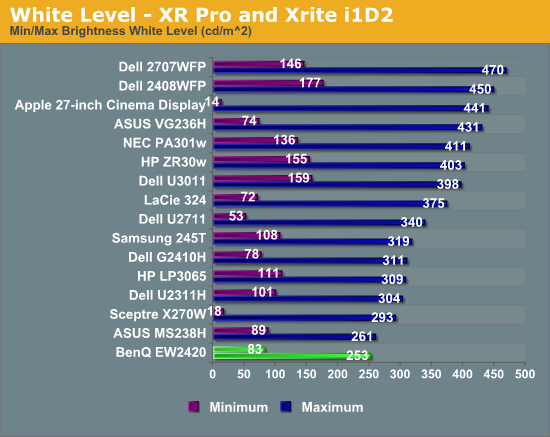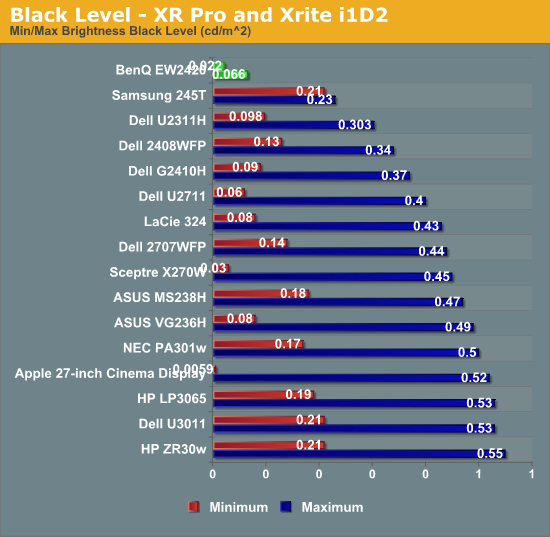BenQ EW2420 Monitor Review
by Chris Heinonen on October 13, 2011 12:00 AM ESTBrightness and Contrast
While the move to an LED instead of a CCFL backlight might mean many things, in the case of the EW2420 it does not mean higher maximum light output. With the backlight and contrast controls at maximum it manages 253 nits of light output. Moving the brightness control down to minimum but leaving the contrast control maximized, the light output falls to 83 nits.

Where the LED backlighting shines is on the light output when displaying a black screen. With the brightness at maximum, the light output with a black screen is only 0.066 nits, and it falls all the way down to 0.022 nits with the brightness at minimum.

What this great black level leads to are superb contrast ratios over 3,800:1 at minimum or maximum brightness, even better than what BenQ specified. This is far more important than the maximum light output since most users will probably use the display somewhere between 100 and 200 nits, and the greater contrast range will be something that you can see. For viewing photos, watching a movie, or playing a game, a higher contrast ratio will make a big difference in the image you can see.

Compared to other displays, the BenQ is far ahead of everyone else. There are other LED lit displays on here, so I’m not sure if it is the combination of the VA panel and the LED lighting, or if they use LED lights with more addressable zones for better light control, or another method. It’s worth nothing that the most advanced LED-backlit televisions can put out a black level below what our test instruments can measure, so monitors still have a little bit further to go with the LED technology, but those sets also are very expensive in comparison.
Brightness Uniformity
With our center measurement at 200 nits, I then measured the light output of a pure white window at nine locations on the screen for the BenQ. While the center and bottom middle locations both are right at that 200 nits level, the light output drops down to the 170-180 nits level at the top of the display.

This is better uniformity than the last display I tested, but it still isn’t quite ideal. Since we disable dynamic contrast, the non-uniform lighting is just a case of the LEDs not being positioned/diffused optimally. The best way to address this is to use rear LED lighting instead of edge LED lighting, but that leads to a far more expensive, and thicker, display than an edge-lit one.

Black uniformity is better than white uniformity. The standard deviation is only 0.007 nits, which is very low. The BenQ is the darkest display I have used on my PC, and it is that way all across the screen.










47 Comments
View All Comments
Lyrick_ - Thursday, October 13, 2011 - link
They're perfect with swivel, I could not function without it. 16:9 for media consumption and gaming. 9:16 for document reading and developing.16:10 is going away, hopefully forever.
TegiriNenashi - Thursday, October 13, 2011 - link
"16:10 is going away, hopefully forever. "People would eventually get tired looking the world through short embrasure even faster than they got bored with 3:4. Many people living rooms have limited widths to the only way for TVs to go bigger is getting more height.
kmmatney - Thursday, October 13, 2011 - link
16:10 is still better for gaming.TegiriNenashi - Thursday, October 13, 2011 - link
For me ideal AR is 16:11 -- compromise between 4:3 and 16:10. Thank you hollywood for ridiculous letterbox (2.55:1!). F..king "Director Artistic Intent"IceDread - Friday, October 14, 2011 - link
16:10 is superior for work and gaming so yeah.IceDread - Thursday, October 13, 2011 - link
I appreciate anandtech continues testing of screens and that input lag is tested.However, it's really annoying with all these small screens.. I really would like to see more 30" screens on the market! This is of course nothing you can do something about, I'm just frustrated that my dream 120 Hz 16:10 30" is still no where near the market. Not even a small 16:9 30" 120 Hz screen...
JarredWalton - Thursday, October 13, 2011 - link
The market appears to be abandoning 30" now and going for 27" 2560x1440 displays -- and ironically, the 27" panels cost just as much or more than some of the older 30" displays! As for your dream of a 120Hz 30" LCD, that's a difficult thing to provide, as you need more bandwidth than even dual-link DVI can provide. I'm not even sure of DisplayPort can send that much data, but I suppose using two DL-DVI links to drive the panel might be possible. Problem there is that you'd have to have some form of new connector, or use two DVI connectors on a graphics card, and I'm not convinced everything would work out well if we go that route (e.g. driver bugs and such).cheinonen - Thursday, October 13, 2011 - link
Technically DisplayPort 1.2 has just enough bandwidth to do 2560 x 1600 x 30 bits x 120 Hz, but I'm not sure when we would see such a beast. I'd love to get a look at one if someone wanted to make it though. It seems that moving to 16:9 from 16:10 is more cost effective for the manufacturers, even if we aren't really seeing that being passed along to the consumer.ggathagan - Friday, October 14, 2011 - link
The only reason that 16:9 is more cost effective than 16:10 is due to consumers .If buyers stayed away from 16:9 panels, they would not be so prevalent in the market.
This is one of many markets that rely on buyers' lack of discrimination.
Zolcos - Wednesday, October 19, 2011 - link
The most frustrating thing about the lack of higher res 120hz monitors is that the technology has been around for some time now.- Anandtech reviewed a 120hz 1080p LCD over a year ago
- 120hz at resolutions higher than 1200p requires DisplayPort 1.2, and AMD video cards supporting it have been around for a year.
The tech is not only available, but in gamers' rigs right now. If only someone would actually make a true 120hz lcd at some 16:10 or 4:3 resolution greater than 1200p I'd drop 2 grand on it right now, I don't even care about the color accuracy.